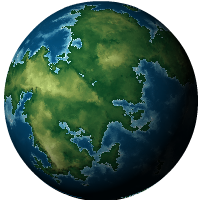Olethros Secunda
| Name | Olethros Secunda |
|---|---|

| |
| Sub-Sector | Secundus |
| Type | Civilised World |
| Population | 2 billion |
| Climate | Temperate |
| Status | Imperial (nominal) |
“We arrived just in time for the Games, and struggled to find any room at all in Backshore. A and the retinue ended up sleeping in the shuttle – it was that or the floor! The views from orbit are stunning – the islands, still green despite the rise of heavy industry, like emeralds set in a gunmetal sea. The victors’ parade was a sight to behold; they all seemed so young and so proud – I wonder if they have any idea what truly awaits them?” Travel Diary of Lucius di Firro, 578.M41
About Olethros Secunda
Olethros Secunda is a balmy, temperate world in a stable orbit around a main sequence G-type yellow dwarf. Violent tectonic activity in its early development led to the formation of no major continents above the sea level; instead, the planet’s habitable southern hemisphere is a vast archipelago of islands, the largest no more than fifty miles in diameter, resting in a shallow, fruitful and mildly alkaline ocean. These islands experience a warm, mild littoral climate, with vegetation rarely growing above large bushes or small trees analogous to cypress, laurel and juniper. The northern hemisphere is almost entirely bereft of land masses, and the oceans are much deeper. Aerial augur surveys report biomass signals consistent with large – very large – organisms in the bathypelagic zones, but no recorded sightings have yet been confirmed. The northern polar cap is host to a small variety of native mammals and birdlife, some of which are hunted for their skins.
The colony of Olethros Secunda was founded in the early 400s.M41. The leader of the original colonisation effort, Brigadier-General (later Governor-General) Akwesi zu Septimian, was granted an Administratum Writ and permission to raise colonist forces from across the local worlds following her loyal service under Warmaster Fassir. However, with no independent wealth and no desire to suborn herself to any of the Sector noble houses, zu Septimian turned to an unusual source for assistance in setting up the equipment and transportation necessary to enable the huge effort of colonising a new world: the newly recontacted Adeptus Mechanicus of Naximus Prime.
Following zu Septimian’s entreaty, the Mechanicum provided the Olethros colonists with all the shipping and logistical support they needed to commence the long process of civilising their wet and empty world. Thousands of sacred machines and their red-robed keepers accompanied the colonists, shortening the work of subduing the oceans to Humankind’s will from generations to months. The inhabited islands of the Southern archipelago are now linked by a network of delicate sky-spanning plasteel bridges, their pilings and foundations maintained by a horde of amphibious Mechanicus servitors who eternally sing watery praises to the Omnissiah as they go about their squamous business.
The population of Olethros today is healthy, stable and expanding, with a robust subsistence economy founded on fishing, mineral extraction from the rich oceans, and substantial olive-groves planted on the larger islands. The planet exports dehydrated and processed fish and seafood popular as a compact and nutritious protein source in military rations, and there is a substantial submarine Mechanicus facility on the ocean floor near the equator – though what precisely it mines, processes and ships to Naximus and the orbital stations nearby is a mystery the red-robed Priests do not share lightly.
The assistance given to Olethros’ founding was not without a cost, though to speak to an Olethran native – all of whom piously regard the Priesthood of Naximus Prime as their first masters, and the Imperium as a distant second – all service rendered to the followers of the Omnissiah is an honour and its own reward. Every five years since the Founding, the sector-famous Olethran Games are held. These Games gather every able youth between the ages of fifteen and thirty, and pit them against each other in trials of strength, song, speed and logic. The winners of the Trials from each Island are brought together on the planetary capital of Backshore, a vast artificial platform which has far outgrown its original island and extends several miles over the open ocean. From these, the finalists compete against each other under the watchful eyes of Mechanicus priests who travel all the way from Naximus for the occasion, and observe the Games from the height of their great three-legged silt-walkers, autonomous platforms designed to easily stride across the shallow seas between Olethran islands. The finalists who succeed most convincingly in the eyes of the Priests are given the great honour of being taken up into the Arks and carried in state back to Naximus Prime, where they serve their new masters as vassals into eternity. These youths are known colloquially as the “Glorious Ten Thousand”, though for religious reasons, the actual number is eight thousand, one hundred and ninety-two – a number more pleasing in the eyes of the Omnissiah.
This arrangement is known as the Righteous Tithe, and its enshrinement in planetary law is responsible for the Olethran Governor’s conviction that the planet is not subject to Imperial taxation. The Sector Administratum ferociously disagrees, and the matter is the subject of a savage ongoing jurisdictional argument between the Subsector Praefector and the Governor, currently Kojo zu Septimian, Akwesi’s eldest child. The Mechanicum of Naximus certainly consider Olethros Secunda part of their domain, and regularly provide Kojo with diplomatic support in their efforts to resist Imperium census-takers and tax-collectors making planetfall. The matter has not yet come to violence, although the Subsector Praefector frequently threatens to call in favours with the Salient commanders if Kojo continues in their steadfast refusal.